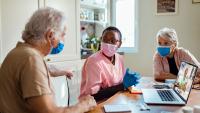Disparities in Infection in Home Health and Patients/Caregivers' Perceptions (Dis-Infection in HHC)

Columbia University School of Nursing is conducting "Disparities in Infection in Home Health and Patients/Caregivers' Perceptions (Dis-Infection in HHC)" in partnership with the Visiting Nurse Service of New York and the University of Rochester.
The study was approved by the wIRB, and is funded by the Agency for Healthcare Research and Quality (AHRQ) (R01HS028637).
Background
Home health care (HHC), which provides important post-acute care for elderly and acutely-ill patients in their own homes,1-3 is playing an even more vital role in helping vulnerable elderly patients with multiple chronic conditions to avoid institutional care during the COVID-19 pandemic.4 HHC patients are at high risk for COVID-19 as well as health care-associated infections (HAIs),5 defined as “infections acquired in the continuum of settings where persons receive health care.”6
In our previous projects (R01HS024723, R01NR016865), we found that infection prevention and control (IPC) is suboptimal in HHC,7 and HHC nurses faced unique challenges with IPC, including uncontrolled home environments and noncompliance with IPC practices among patients and informal caregivers.8,9 We also found HHC patients living in areas with lower levels of income and education have a higher risk of developing infections that lead to emergency room visits and/or hospitalizations.10
However, this analysis is limited by the age of the data (2013 data) and narrow measures of community socioeconomic status (SES). These are important limitations considering the stark disparities identified in COVID-19 hospitalizations and deaths across racial/ethnic and socioeconomic lines,11-13 suggesting more research is needed to understand the scope of infection-related health disparities specifically focusing on the HHC setting.
In the current health care landscape, greater responsibility is being placed upon HHC patients and/or their informal caregivers. Evidence is needed to guide how best to engage HHC patients and caregivers in effective IPC practices. A critical first step is to understand their knowledge and perspectives related to IPC.
Study Goals
Building upon our previous studies and guided by the Social-Ecological Model (SEM) for Health Promotion,14 we will merge multiple national datasets from 2019-2020 with the latest Area Deprivation Index (ADI) file, a multidimensional SES measure of neighborhoods, to study infection-related health disparities before and during the COVID-19 pandemic.
We will study hospital transfers or emergency care visits due to four commonly reported HAIs in HHC (respiratory, urinary tract, wound, and intravenous catheter-related) that occur two days after HHC admission as well as COVID-19 infections.
Next, patients with high and very high risk of infection and/or their informal caregivers (n = 250) from two HHC agencies serving patients with diverse socioeconomic backgrounds in large geographic areas will be surveyed to understand their IPC-related knowledge, attitudes, practices, and environmental risk factors. Using innovative dyadic interview analysis of both patient (or informal caregiver) and HHC provider interviews (40 pairs), we will better understand patient/caregivers’ barriers to IPC and explore how best to enhance patient (or informal caregiver)-HHC provider interactions and improve IPC practices at home.
Finally, we will triangulate the results from our administrative data analyses, surveys, and qualitative interviews to develop a multi-modal intervention to improve IPC knowledge and practices among HHC patients and informal caregivers, and pilot test it in 30 patients from diverse racial/ethnic and SES backgrounds.
Study Aims
- Examine socioeconomic disparities in infection events, including COVID-19, among HHC patients before and during the COVID-19 pandemic.
- Describe IPC-related knowledge, attitudes, and practices among HHC patients (or informal caregivers) and examine associated factors.
- Explore IPC practices from the perspectives of HHC patients (or informal caregivers) and HHC provider.
- Develop and pilot test a multi-modal intervention to improve knowledge and practice of IPC in HHC patients (or informal caregivers).
References
- Jarvis WR. Infection control and changing health-care delivery systems. Emerg Infect Dis. 2001;7(2):170-173.
- Medicare Payment Advisory Commission (MedPAC). Report to the Congress: Medicare Payment Policy. Published March 2020. Accessed January 21, 2021.
- Thome B et al. Home care with regard to definition, care recipients, content and outcome: systematic literature review. J Clin Nurs. 2003;12(6):860-872.
- Bowles KH et al. Surviving COVID-19 After Hospital Discharge: Symptom, Functional, and Adverse Outcomes of Home Health Recipients. Ann Intern Med. 2021;174(3):316-325.
- Shang J et al. Infection in home health care: Results from national Outcome and Assessment Information Set data. Am J Infect Control. 2015;43(5):454-459.
- Collins A. Preventing Health Care-Associated Infections. In: Hughes R, ed. Patient Safety and Quality: An Evidence-Based Handbook for Nurses. Rockville, MD: Agency for Healthcare Research and Quality; 2008.
- McDonald MV et al. Observation of Hand Hygiene Practices in Home Health Care. J Am Med Dir Assoc. 2020 Sep 15;S1525-8610(20)30656-3.
- Adams V et al. Infection prevention and control practices in the home environment: Examining enablers and barriers to adherence among home health care nurses. Am J Infect Control. 2021;49(6):721-726.
- Dowding D, et al. Home care nurses' identification of patients at risk of infection and their risk mitigation strategies: A qualitative interview study. Int J Nurs Stud. 2020;107:103617.
- Shang J et al. Infection Related Socioeconomic Disparities in Home Health Care. Presented at the AcademyHealth 2017 Annual Research Meeting, June 26, 2017, New Orleans.
- Gary S KL et al. Hospitalization Rates and Characteristics of Patients Hospitalized with Laboratory-Confirmed Coronavirus Disease 2019 — COVID-NET, 14 States, March 1-30, 2020. CDC;2020.
- Wadhera R et al. Variation in COVID-19 hospitalizations and deaths across New York City boroughs. JAMA. 2020;323(21):2192-2195.
- Chowkwanyun M, Reed Jr AL. Racial Health Disparities and Covid-19—Caution and Context. N Engl J Med. 2020 Jul 16;383(3):201-203.
- Bronfenbrenner U. The ecology of human development: Experiments by Nature and Design. Cambridge, MA: Harvard University Press; 1979.


